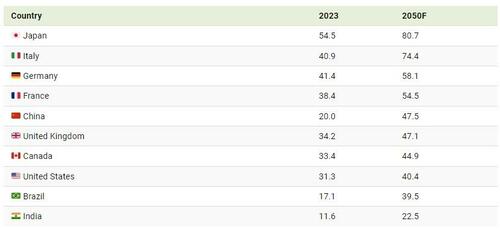This Is The Chart That Keeps Japanese Policymakers Up At Night
Japan has a demographic crisis that started in 2017 and picked up steam in 2020 and will accelerate from there into at least 2050… as a high life expectancy and a low birth rate has created an unprecedented aging population.
As a simple and effective measure of that ‘crisis’, we look at the old-age dependency ratio measures the number of people over the retirement age of 65 for every 100 working-age people.
The higher dependency ratio means fewer workers are supporting a growing number of retirees, which strains social security systems, healthcare, and pension funds. This situation could lead to economic stagnation or decline unless addressed through policy changes like increasing immigration or boosting birth rates.
In charts by creator Preyash Shad, Visual Capitalist looks at old-age dependency ratios of the top 10 economies based on data from the Organisation for Economic Co-operation and Development (OECD).
Japan in Trouble
Japan has had a rapidly rising old-age dependency ratio for several decades and has the highest ratio currently at 54.5.
Meanwhile, Germany is the runner-up in the top 10 economies with a distant second-place dependency ratio of 41.4.
At the same time, the United States maintains a relatively low old-age dependency, with a ratio of 31.3, which places it seventh among the top 10 economies.
India, now the world’s most populous country, has the lowest ratio of 11.6, in large part because it also has the youngest population.
Projections for 2050
By 2050, Japan will maintain the highest old-age dependency ratio of the group, moving from 54.5 to a staggering 80.7.
In an effort to head-off such a high ratio, Japan is has put policies in pace to attract young immigrants and migrant workers.
However, despite government incentives, cultural shifts towards later marriages, fewer children, and more women entering the workforce have not significantly reversed the trend in Japan (or many other nations).
Italy, which is facing similar demographic pressures, will move from distant third to a close second, moving from a ratio of 40.9 to 74.4.
China, because of the results of the one-child policy and low immigration, could surpass the U.S. by 2050 with a ratio of 47.5.
Tyler Durden
Thu, 08/22/2024 – 20:30
via ZeroHedge News https://ift.tt/5ArD9L0 Tyler Durden


